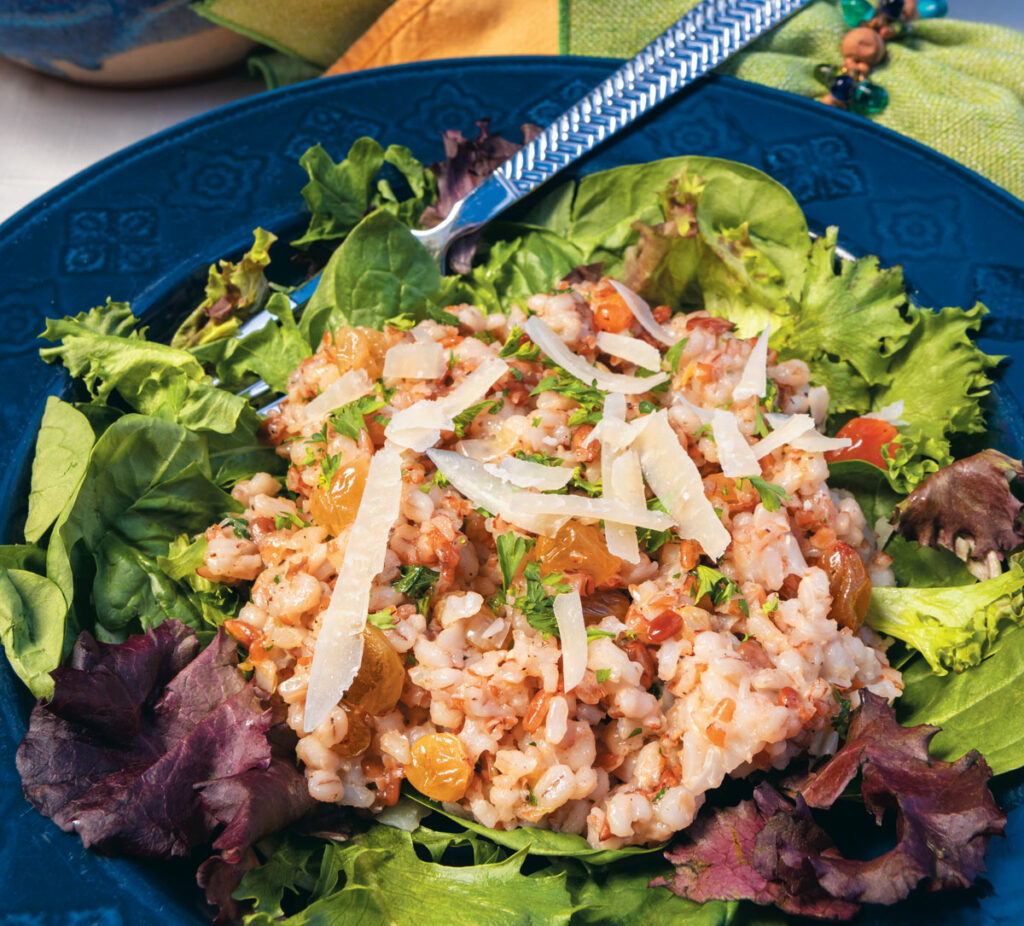They may be tiny, but they’re packed with nutrition!
“Mighty oaks from little acorns grow …” That’s an adage used since the 14th century to encourage beginners intimidated by a project ahead — and a gentle reminder to anyone who might discourage them. Really, though, it’s just science and a great demonstration of all the nutritional potential that resides in every seed. Adding yummy edible seeds to your diet is a great way to access the same energy that pushes an oak tree toward the sky. Try some of these recipe ideas, and you’ll feel mightier in no time!
- 4 cups low-sodium chicken stock
- 2⅓ cups quinoa
- ⅓ cup chopped fresh cilantro
- 8 Roma tomatoes, chopped
- 2 green onions, chopped
- ¾ cup sunflower seeds
- ¼ cup pine nuts
- 2 tablespoons tahini
- 4 tablespoons olive oil
- Juice of 2 lemons
- ½ teaspoon garlic salt
- ½ teaspoon black pepper
- ¼ teaspoon cayenne
- Place the stock in a heavy saucepan and bring to a boil. Add the quinoa and boil for 1 minute, then reduce the heat and simmer for 12 minutes covered or until all the liquid has been absorbed. Set aside to cool for 10 minutes.
- Stir in the cilantro, tomatoes, onions, sunflower seeds, pine nuts, tahini, olive oil, lemon juice, salt, pepper and cayenne. Serve immediately or cool completely and refrigerate until ready to serve cold or at room temperature.
- 1⅓ cups almonds
- 20 pitted dates
- 4 tablespoons cocoa powder
- 2 tablespoons almond butter
- 2 tablespoons coconut oil
- 2 tablespoons chia seeds
- Place the almonds in the bowl of a food processor and crush for 20 seconds. Add the dates, cocoa powder, almond butter, coconut oil and chia seeds along with 2 tablespoons of water. Process until blended, around 20 seconds longer.
- Roll into 2 dozen balls and place on a baking sheet lined with parchment. Place in the freezer for 1 hour, then transfer to an airtight container and store in the refrigerator. Serve cold.
- 1½ cups coarsely chopped pecans or walnuts
- ⅔ cup slivered almonds
- 3 cups oats
- 1⅓ cups pumpkin seeds
- 1¼ cups sunflower seeds
- ⅔ cup flaxseeds
- 3 tablespoons coconut oil, melted
- 3 tablespoons maple syrup
- 3 teaspoons ground cinnamon
- 1¼ cups raisins
- Preheat the oven to 400 degrees. Lightly grease a large baking sheet and set aside. Place the pecans or walnuts, almonds, oats, pumpkin seeds, sunflower seeds and flaxseeds in a large mixing bowl. Stir together the melted coconut oil, maple syrup and cinnamon until well blended. Drizzle over the seed mixture, stirring well to evenly coat.
- Transfer to the prepared baking sheet and spread evenly over the sheet. Bake for 30 minutes, stirring every 10 minutes. Set aside to cool completely and stir in the raisins. Store in an airtight container at room temperature.
- 3 tablespoons cider vinegar
- 1 large shallot, peeled and chopped
- ½ teaspoon salt, divided
- ½ teaspoon black pepper, divided
- 2 tablespoons honey
- 2 tablespoons olive oil
- 3 teaspoons Dijon mustard
- 2 teaspoons poppy seeds
- ⅓ cup sunflower seeds
- 24 ounces fresh kale, stemmed and coarsely chopped
- 1 green apple (such as Granny Smith), cored and coarsely chopped
- 1 red apple (such as Fuji or winesap), cored and coarsely chopped
- In a jar with a tight-fitting lid, combine the vinegar, shallots and ¼ teaspoon of the salt. Set aside for 10 minutes. Add ¼ teaspoon of the pepper, honey, olive oil, mustard and poppy seeds. Cover and shake vigorously to combine. Set aside.
- In a dry skillet over medium heat, add the sunflower seeds. Toast and toss for 3 minutes or until lightly browned. In a serving bowl, toss together the kale, green apples and red apples. Sprinkle with the remaining salt and pepper. Add the sunflower seeds and toss well. Shake the dressing again to emulsify and drizzle over the salad. Serve immediately.
- 4 (4-ounce each) boneless, skinless chicken breasts
- 1 white onion, peeled and quartered
- 2 garlic cloves, minced
- 1 (1-inch) piece fresh ginger, peeled and diced
- ½ teaspoon salt
- 2 teaspoons ground coriander
- 1 teaspoon dried crushed red pepper
- 3 tablespoons lime juice
- 3 tablespoons low-sodium soy sauce
- 2 tablespoons canola oil
- 1 tablespoon chopped fresh chives
- ¼ cup sesame seeds, toasted
- Place the chicken in a single layer in a shallow baking dish. Process the onions, garlic, ginger, salt, coriander, pepper, juice, soy sauce and oil in a food processor until smooth. Pour over the chicken. Cover and refrigerate overnight.
- Preheat the oven to 375 degrees. Remove the chicken from the marinade and discard the marinade. Place the chicken on a lightly greased roasting pan and sprinkle with the chives and sesame seeds. Bake 20 minutes on each side or until completely done. Serve hot.
- 4 (4-inch-long) cinnamon sticks, broken into pieces
- 2 whole star anise
- 5 tablespoons cardamom pods
- 2 tablespoons whole cloves
- 1 tablespoon coriander seeds
- ¼ teaspoon whole black peppercorns
- 1 teaspoon ground ginger
- Place the cinnamon sticks, star anise, cardamom pods, cloves, coriander and peppercorns in a dry skillet over medium heat. Toast and toss for 3 minutes. Remove from the heat and cool for 3 minutes. Transfer to a mortar and pound briefly with the pestle to crush. If you don’t have a mortar and pestle, crush with a rolling pin on a piece of waxed paper. Transfer to an airtight container and add the ginger.
- When ready to use, place 2 heaping teaspoons in a small saucepan with 1 cup of milk and 2 teaspoons of brown sugar. Place over medium heat just until the mixture bubbles around the edges. Remove from the heat, cover and steep for 10 minutes. Meanwhile, brew 2 cups of Darjeeling tea. Strain the spiced milk into the hot tea. Serve immediately.
Tammy Algood develops recipes for The Tennessee Magazine that feature farm-fresh Tennessee food. Those fresh, local ingredients will always add cleaner, more flavorful foods to your table. We recommend visiting local farms and farmers markets to find the freshest seasonal produce.
Seeds of knowledge

Seeds, no matter their actual size, contain fairly high amounts of natural oil. This gives the larger ones that are sometimes used as snacks (such as sunflower and pumpkin) their characteristic crunch, particularly when roasted. This also can make them prone to becoming rancid if not stored properly. Keep the containers tightly closed and either in the refrigerator or freezer. If the seeds are purchased or transferred to bags, squeeze as much air out of the bag as possible before sealing. There is no need to thaw seeds that have been kept in the freezer before use.
Note: Flaxseeds can be difficult to digest for some, so instead of using whole seeds, grind them into meal. Although you can use a small food processor or a mortar and pestle for this task, a coffee grinder or an old pepper mill is much easier, faster and simpler to clean.
Ask Chef Tammy

Email your cooking questions to Tammy Algood: talgood@tnelectric.org.
Mary Virginia writes: “I received a free sample of Hungarian paprika in a spice order I placed and used it on my breakfast scrambled eggs. It was much hotter than the normal Hungarian paprika I usually purchase. Are there different kinds, or is there something I can look for to warn me of the heat?”
Mary Virginia, there are actually six main grades of Hungarian paprika, and my guess is you probably received a sample of Eros Hungarian paprika. It is the hottest of all the grades and sometimes even a bit bitter. The distinction should be listed on the label. Eros is generally a coarser texture than other forms of paprika and typically a darker red color.
Robert asks: “I have a handwritten recipe of a friend who has since passed that calls for a cup of grated marrow squash. I have never heard of this particular variety, and the produce manager at my supermarket hasn’t either. Can you give me a suggestion of a worthy substitute for it? The recipe is a casserole.”
Robert, marrow squash is another name for zucchini! It also has been called vegetable marrow.
Ellen has a great fruit salad recipe that calls for passion fruit. “I love this in the salad and have no problems finding it in the summer and early fall but have more difficulty locating it after the first of the year. What other fruit can I use instead that will be available from February through the spring? I have just put it away in the past during those months but thought you might have a suggestion,” she writes.
Ellen, your best bet is to use mango. It won’t have the same flavor profile unless you add a splash of citrus juice to the recipe. Use lemon, lime or grapefruit to enhance the acidity and give it more “passion.”



